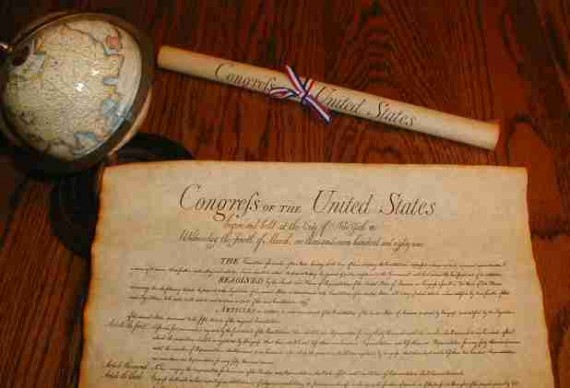Forest Service Requires Media To Pay Fees To Take Pictures On Government Land
Freedom Of The Press, if you can afford to pay the fee.
If you’re a member of the media and you want to take pictures or shoot video inside a National Park as part of a story you’re covering, you’ll have to pay some hefty fees to the Forest Service:
The U.S. Forest Service has tightened restrictions on media coverage in vast swaths of the country’s wild lands, requiring reporters to pay for a permit and get permission before shooting a photo or video in federally designated wilderness areas.
Under rules being finalized in November, a reporter who met a biologist, wildlife advocate or whistleblower alleging neglect in any of the nation’s 100 million acres of wilderness would first need special approval to shoot photos or videos even on an iPhone.
Permits cost up to $1,500, says Forest Service spokesman Larry Chambers, and reporters who don’t get a permit could face fines up to $1,000.
First Amendment advocates say the rules ignore press freedoms and are so vague they’d allow the Forest Service to grant permits only to favored reporters shooting videos for positive stories.
“It’s pretty clearly unconstitutional,” said Gregg Leslie, legal defense director at the Reporters Committee for Freedom of the Press in Alexandria, Va. “They would have to show an important need to justify these limits, and they just can’t.”
Liz Close, the Forest Service’s acting wilderness director, says the restrictions have been in place on a temporary basis for four years and are meant to preserve the untamed character of the country’s wilderness.
Close didn’t cite any real-life examples of why the policy is needed or what problems it’s addressing. She didn’t know whether any media outlets had applied for permits in the last four years.
She said the agency was implementing the Wilderness Act of 1964, which aims to protect wilderness areas from being exploited for commercial gain.
“It’s not a problem, it’s a responsibility,” she said. “We have to follow the statutory requirements.”
The Forest Service’s previous rules caused a fuss in 2010, when the agency refused to allow an Idaho Public Television crew into a wilderness area to film student conservation workers. The agency ultimately caved to pressure from Idaho Gov. C.L. “Butch” Otter.
With smartphones blurring the lines between reporters and camera crews, U.S. Sen. Ron Wyden, an Oregon Democrat, said the agency should tread more carefully.
“The Forest Service needs to rethink any policy that subjects noncommercial photographs and recordings to a burdensome permitting process for something as simple as taking a picture with a cell phone,” Wyden said. “Especially where reporters and bloggers are concerned, this policy raises troubling questions about inappropriate government limits on activity clearly protected by the First Amendment.”
(…)
The rules allow exceptions only for breaking news coverage of events like fires and rescues. They’re more stringent than similar policies on wilderness areas managed by a different federal agency, the Bureau of Land Management.
The BLM does not require any special permit for newsgathering in wilderness areas.
By contrast, the Forest Service is giving its supervisors discretion to decide whether a news outlet’s planned video or photo shoots would meet the Wilderness Act’s goals.
“If you were engaged on reporting that was in support of wilderness characteristics, that would be permitted,” Close said.
The First Amendment prohibits the creation of laws that abridge press freedom. Asked whether the Forest Service believes its rule violates the First Amendment, Close replied: “It does not apply to breaking news.”
The problems with this policy are manifest. Right off of the top, the Forest Service spokesperson’s claim that there are no First Amendment issues because the policy does not apply to “Breaking News,” which from the reports I read is a definition that is entirely within the discretion of the Forest Service, is simply nonsense. Freedom of the press is about far more than covering “breaking” news such as a forest fires, search and rescue operations, or searches for escaped fugitives, which seem to be the only things that would constitute “breaking” news in this context. It also means covering long term stories, or allegations of mismanagement and corruption by government officials. What if, for example, a national or local television news reporter were covering a story based on allegations of malfeasance by Forest Service officials that made taking video on Forest Service land relevant? How, in that context, is a reporter supposed to apply for a permit to begin with? From the descriptions of the process, it appears that media outlets are required to provide some kind of justification for why they need the video in question, and in this case that would require the reporter to either lie to a government official or potentially reveal the story they are working on to people who are the focus of that investigation. In a case like that, if a permit is denied, the strong implication would be that the agency had something to cover up because of the manner in which it was restricting press access.
Another question, of course, is the question of what exactly is covered by this policy. Anderson Cooper showing up with a CNN camera crew would obviously be covered, but what about someone who happens to be employed as a reported who shows up with their smartphone, are they going to be required to pay a fee if they shoot some video with that camera? What about people who don’t work for “traditional” media organizations? Heck, what about a tourist who just happens to capture something on their own video camera or smartphone that ends up being newsworthy after the fact? The most disturbing part of this idea is that only people who can afford to pay the fee are allowed to shoot video on land managed by the Forest Service, and that the agency has at least some control over who gets the permits in the first place. That’s a problem both because of the manner in which it quite obviously can act as a restraint on Freedom of the Press, but also because it gives a government agency the authority to decide who is and who isn’t a journalist. As we’ve seen with the issues surrounding the efforts of SCOTUSBlog to get a press pass to cover the Supreme Court, that’s problematic to say that very least.
There is some government interest implicated here, admittedly. News crews being allowed to traipse unfettered over lands that are meant to be preserved could end up causing damage and disturbing wildlife. However, there are obviously less restrictive and less onerous means of dealing with those potential problems than the process in place now. Requiring reporters to get permission to cover the government, however, and to pay a hefty fee for the something that is a Constitutional right, is clearly a bridge to far. If the policy isn’t changed, then hopefully someone will bring a test case and get this before a Court.






This is just ridiculous. There is probably some other motivation behind this besides protecting the wilderness. If that is the true situation, then reasonable restrictions could be in place such as on the use of motor vehicles, free permits, etc. Permits are used all the time for camping, hiking, etc and there is legitimate reasons for them. But the way this is implemented is wrong.
This leapt out at me:
In general, “time, place, and manner” restrictions need to be content neutral. This is CERTAINLY not content-neutral.
The line about a National Park in the first sentence isn’t right, since it is the National Park Service that’s in charge of them. The Forest Service is in charge of the National Forests (mostly).
Permits cost up to $1,500, …., and reporters who don’t get a permit could face fines up to $1,000.
That’s actually pretty funny. Who says government rules make no sense?
@edmondo:
Damn, beat me to it.
So shouldn’t reporters, then, just go ahead and film what they want and pay the fine? They save $500.
Apparently the Forest Service does not have a General Counsel’s office and folks at the Department of Agriculture must of not answered the e-mail. I expect that within a few days, like with the Air Force, we will get a notice of “Sorry, after checking with the GC, we will relookt this policy.”
I suspect this is much ado about nothing.
The directive addresses still photography and commercial filming.
There is a distinct difference between commercial filming and news-gathering. If someone is making money…they should have to pay a fee. Just like Clive Bundy is supposed to. He owes us all over a million bucks.
Leapin’ lizards…a commercial film company has to pay permits to film in NYC. News-gathering operations don’t. I’ve never shot on the streets of NYC…but in Miami, for instance, a city-issued press pass is pretty much a requirement.
Evil capitalists traipsing through the forest, sucking the souls out of our trees and birds with their horrible money cameras!! WHERE WILL IT END!?!?
@C. Clavin:
Not many people realize this, but journalists are really only into news gathering for the congratulatory hugs they get from their editors at the end of the week.
Are there really that many journalists traipsing around the national forests that they needed to put this rule into effect? What the heck are they covering – pot growers and illegal hunting?
The most transparent administration EVAH!
OMG! Our liberty is hanging by a thread! Tyranny is breathing down our necks!
@beth:
The original article suggests that the fines are being selectively levied to punish reporters who file stories that aren’t favorable toward the Forest Service.
@Stormy Dragon: I guess it’s because of where I live but I honestly can’t remember the last time I read or heard a news story, favorable or not, about the Forest Service.
@Neil Hudelson: And THAT’s only if they get caught.
An Update for you.
Right, delaying. They got caught with their hands in the cookie jar.
The lawyers working for the Forest Service (USFS) have said, oops, we really didn’t mean to make ourselves personally liable to a civil rights violation. We thought as almighty bureaucrats that we are better than you proles. Meanwhile the Congressional Delegations of OR and WA were about to issue a joint letter expressing dismay with the USFS’s sudden looney interpretation of a 1960s law.
To clarify matters (as others have done above) out West, there are lots of federal jurisdictions that control most of the land.
National Parks are Dept of the Interior
US Forestry Service – Department of Agriculture – National Forests and Wilderness Areas
BLM – Bureau of Land Management ( aka mis-management) – Dept of the Interior – everything else (including National Monuments)
The proposed new law (oops, it is a regulation, administrative law) applies to “Wilderness Areas” which rarely have a road going through them. About half of the Cascade Mountains are in the “Wilderness”category. Anyone entering has to get a permit with a pay a nominal processing fee ($10), but media now need $1500? Arranged months in advance?
A specific example of the impact that I know of is a “filler” series on NorthWest Cable News (KING5/BELO) called NorthWest Postcards where a younger reporter/meteorologist goes to someplace interesting. Of the roughly 150 episodes over the past 5 years (and they repeat as filler on slow news days), I’d say 10 are inside wilderness areas (Eagle Cap, Mt Adams, Mt Baker, Lookout Peak). You see him climbing Mt Adams (volcano) with a Go-Pro Camera on a stick on his regular outdoor activities. His bosses wouldn’t pay $1500 for the privilege of him carrying a Go-Pro hiking up the mountain, and glissading down it..[Ed Muir, NWCN] So the rule is defacto government censorship by the pocketbook.
Anyways, crisis averted for now. But how about reprimands on those that proposed this? What are their names?
This story is based on poor original reporting and subsequent click baiting. There is an exemption for news media. This is geared towards curbing/mitigating damaging commercial shooting in wilderness areas. Lots of outrage, no real substance. This blog post should be updated. Also seehttp://www.modernhiker.com/2014/09/25/the-forest-service-wont-charge-you-1500-for-photos/ and comments for clearer information.
information from the Forest Service: http://www.fs.fed.us/news/releases/us-forest-service-chief-i-will-ensure-first-amendment-upheld-under-agency-commercial. Again: media are exempt. This rule actually is about protecting wilderness areas.